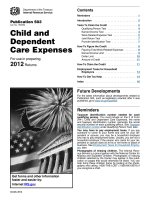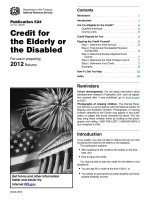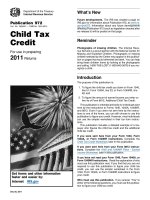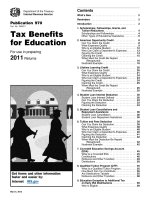Designation: C 688 – 00 - Functional Additions for Use in Hydraulic docx
Bạn đang xem bản rút gọn của tài liệu. Xem và tải ngay bản đầy đủ của tài liệu tại đây (34.49 KB, 5 trang )
Designation: C 688 – 00
Standard Specification for
Functional Additions for Use in Hydraulic Cements
1
This standard is issued under the fixed designation C 688; the number immediately following the designation indicates the year of
original adoption or, in the case of revision, the year of last revision. A number in parentheses indicates the year of last reapproval. A
superscript epsilon (e) indicates an editorial change since the last revision or reapproval.
1. Scope
1.1 This specification covers methods to investigate the
effectiveness of a material to beneficially change the properties
of hydraulic cements when the material is interground with the
clinker during manufacture of the cement.
1.2 The values stated in SI units are to be regarded as the
standard.
1.3 The effect of additions in cement may markedly change
properties other than those they are intended to modify. This
specification is designed to test for such changes. Table 1 sets
forth values for those properties of cement pastes and mortars
that would permit a judgment of the changes effected by an
addition. Likewise, Table 2 sets forth similar criteria for
concrete. Certain additions may be found effective for more
than one purpose as indicated in 3.1.4 and 3.1.5.
2. Referenced Documents
2.1 ASTM Standards:
C 39 Test Method for Compressive Strength of Cylindrical
Concrete Specimens
2
C 78 Test Method for Flexural Strength of Concrete (Using
Simple Beam with Third-Point Loading)
2
C 109/C 109M Test Method for Compressive Strength of
Hydraulic Cement Mortars (Using 2-in. or 50-mm Cube
Specimens)
3
C 143 Test Method for Slump of Hydraulic Cement Con-
crete
2
C 150 Specification for Portland Cement
3
C 151 Test Method for Autoclave Expansion of Portland
Cement
3
C 157 Test Method for Length Change of Hardened Hy-
draulic Cement Mortar and Concrete
2
C 187 Test Method for Normal Consistency of Hydraulic
Cement
3
C 191 Test Method for Time of Setting of Hydraulic Ce-
ment by Vicat Needle
3
C 219 Terminology Relating to Hydraulic Cement
3
C 226 Specification for Air-Entraining Additions for Use in
the Manufacture of Air-Entraining Portland Cement
3
C 232 Test Method for Bleeding of Concrete
2
C 234 Test Method for Comparing Concretes on the Basis
of the Bond Developed with Reinforcing Steel
2
C 266 Test Method for Time of Setting of HydraulicCement
Paste by Gillmore Needles
3
C 403 Test Method for Time of Setting of Concrete Mix-
tures by Penetration Resistance
2
C 451 Test Method for Early Stiffening of Portland Cement
(Paste Method)
3
C 465 Specification for Processing Additions for Use in the
Manufacture of Hydraulic Cements
3
C 595M Specification for Blended Hydraulic Cements
3
C 596 Test Method for Drying Shrinkage of Mortar Con-
taining Portland Cement
3
C 666 Test Method for Resistance of Concrete to Rapid
Freezing and Thawing
2
C 845 Specification for Expansive Hydraulic Cement
3
C 1157M Performance Specification for Blended Hydraulic
Cement
3
3. Terminology
3.1 Definitions:
3.1.1 accelerating addition—a functional addition that ac-
celerates the setting or early strength, or both, of concrete and
mortar.
3.1.2 retarding addition—a functional addition that retards
the setting of concrete and mortar.
3.1.3 set-control addition—a functional addition composed
essentially of calcium sulfate in any hydration state from
CaSO
4
to CaSO
4
·2H
2
O.
3.1.4 water-reducing addition—a functional addition used
to reduce the quantity of mixing water required to produce
concrete and mortar of a given consistency.
3.1.5 water-reducing and accelerating addition—a func-
tional addition that reduces the quantity of mixing water
required to produce concrete of a given consistency and that
accelerates the setting or early strength development, or both,
of concrete and mortar.
3.1.6 water-reducing and retarding addition—a functional
addition that reduces the quantity of mixing water required to
produce concrete and mortar of a given consistency and
simultaneously retards the setting of concrete and mortar.
NOTE 1—This section is intended to provide a specification that may be
applied to calcium sulfates as defined in Terminology C 219.
N
OTE 2—It should be realized that some calcium sulfates, particularly
1
This specification is under the jurisdiction of ASTM Committee C01 on
Cement and is the direct responsibility of Subcommittee C01.20 on Additions.
Current edition approved June 10, 2000. Published September 2000. Originally
published as C 688 – 71 T. Last previous edition C 688 – 96.
2
Annual Book of ASTM Standards, Vol 04.02.
3
Annual Book of ASTM Standards, Vol 04.01.
1
Copyright © ASTM, 100 Barr Harbor Drive, West Conshohocken, PA 19428-2959, United States.
some byproduct calcium sulfates, have produced cements with undesired
set behavior after storage.
4. Ordering Information
4.1 The purchaser shall specify the type of functional
addition desired.
5. Materials
5.1 Cements—The cements used in the evaluation of the
addition shall be as described in Section 4.1 of Specification
C 465 with the following exceptions:
5.1.1 At least one of the Type I cements shall contain not
less than 9 percent tricalcium aluminate (C
3
A).
5.1.2 Disregard the last sentence of Section 4.1.5 of Speci-
fication C 465 and substitute the following:“ Each control
cement shall comply with all the requirements in the specifi-
cation (C 150, C 595, C 845, and C 1157M) applicable to that
type of cement. The method shall be adequate for the qualita-
tive and quantitative determination of the addition in the
finished cement, and shall be fully described in the report of the
tests on the addition.”
5.2 Aggregates—The aggregates used in the evaluation of
the addition shall be in accordance with the Aggregates portion
of the Materials section of Specification C 465, using propor-
tions specified in Concrete Mixtures section of that specifica-
tion.
6. General Requirements
6.1 The cement, mortar, and concrete in which each of the
additions is used shall conform to the respective requirements
prescribed in Table 1 and Table 2, except that if the test cement
fails to meet the requirements of Table 1, but possesses all the
requirements listed in Table 2, then the requirements of Table
2 shall govern approval of the addition.
6.2 The trade name, source, and character of the material
shall be specified and the means for the quantitative determi-
nation of the proposed addition in the finished cement, shall be
furnished by the manufacturer or seller of the addition, and the
results of such pertinent quantitative analysis shall form a part
of the record of tests of the addition.
6.3 At the request of the purchaser of an addition for a
specific functional purpose, the manufacturer shall state in
writing the content of any substance which is known to or
believed to impair other desirable properties of the cement or
concrete.
6.4 The additions shall be evaluated by comparing cements
containing the “test addition” to cements ground from similar
clinkers from the same source. Those cements without test
additions are referred to in this specification as “control
cements.”
6.4.1 Special Provisions for Set-Control Additions Con-
forming to 3.1.3:
TABLE 1 Criteria for Evaluating Neat Cement and Mortar Containing Functional Cement Additions
Tests
Type of Addition
Water Reducing Retarding Accelerating
Water-Reducing
and Retarding
Water-Reducing and
Accelerating
Set-Control
Normal consistency, deviation from control,
percentage points
A
−1.0 min +1.0 max +1.0 max −1.0 min −1.0 mm 61.0 max
Standard consistency (flow) deviation from
control, percentage points
A
−4.0 min +2.0 max +2.0 max −4.0 min −4.0 min 62.0 max
Setting time, (Gillmore) deviation from control,
h:min
Initial
At least 1:00 later
B
1:00 later
B
Not more than 1:00 earlier 3:30 later 1:30 earlier 3:30 later 1:30 earlier 1:00 earlier
nor nor nor nor
1:30 later 1:30 later 1:30 later 1:30 later
Setting time, Vicat Initial
C
At least 0:50 later
B
Not more than 0:50 earlier 2:50 later 1:15 earlier 0:50 later
B
1:15 earlier 0:50 earlier
nor nor nor nor
1:15 later 1:15 later 2:50 later 1:15 later 1:15 later
Final
Not more than 1:00 earlier 3:30 later 1:00 earlier 3:30 later 1:00 earlier 1:00 earlier
nor nor nor nor
1:30 later 1:30 later 1:30 later 1:30 later
Compressive strength, min, percent of control:
D
1 day in moist air 110 90 125
E
90 125
F
1 day in moist air, 2 days in water 110 90 125
E
100 125
1 day in moist air, 6 days in water 110 90 100 110 110
1 day in moist air, 27 days in water 110 95 95 110 110
Autoclave Expansion
max increase in % change in length compared
to control
0.10 0.10 0.10 0.10 0.10 0.10
Drying Shrinkage of Mortar
max % change in length compared to control 0.020 0.020 0.030 0.020 0.020 0.020
A
The minus sign indicates that the percentage of water required shall be less than that of the control cement by at least the indicated percentage points.
B
Or 50 % later, whichever is the lesser.
C
Either Vicat or the Gilmore time of setting method shall be used at the choice of the manufacturer.
D
The compressive strength of mortar containing the test cement shall be not less than 95 % of that attained at any previous test age. The objective of this limit is to
require that the strength of mortar containing the addition under test shall not decrease with age.
E
In cases where the accelerated set time only is required, the strength can be reduced to 100 % of the control.
F
The grand average of the 1, 3, 7, and 28-day strengths shall be not less than 95 % of the grand average for the corresponding control cement.
C 688
2
6.4.1.1 The additions shall be evaluated by comparing
cements containing the “test addition” to control cements
ground from similar clinkers from the same source and under
the same grinding conditions with the mill temperatures being
within 63°C (5°F) of the same value. The control cements
shall be produced with calcium sulfate at any hydration state
having a past record of satisfactory usage as an addition for
portland cement.
6.4.1.2 Each test cement shall contain sufficient test addition
CaSO
4
to produce a sulfur trioxide (SO
3
) content that differs by
no more than 0.24 percentage points from that of the control
cement. The SO
3
shall be expressed as a percentage of the mass
of the cement and reported to the nearest 0.01 %.
6.4.1.3 The test cements containing the additions shall
conform to the requirements of 8.1 and Table 1. The cements
need not be tested in concrete according to the requirements of
8.2 and Table 2.
6.5 The amount of addition to be interground with the
cement for evaluation purposes shall be such as to produce the
desired effects as listed in Table 1. When these tests show
compliance with the requirements of this specification, the
addition shall be used only in amounts up to the maximum
amount tested in any one of the five cements used in the
evaluation. For a cement requiring more than the established
amount, a separate compliance test on this one cement can be
made which will then establish the new maximum amount
which can be used.
6.6 The cement produced with the functional additions
shown in Section 3 shall comply with the specification for the
respective cement and the ordinarily determined properties of
cement paste, mortar, or concrete made with the cement
containing the test addition shall not differ from these same
properties of the cement paste, mortar, or concrete made with
the control cement as indicated by the standard tests, except as
provided in Table 1 and Table 2.
6.7 Generally, the addition rates required for functional
purposes are several times greater than those needed for
processing purposes and the resultant increase in flowability, or
lubricity, from these increased addition rates may cause suffi-
cient reduction in mill retention time to affect significantly the
TABLE 2 Criteria for Evaluating Concrete Containing Functional Cement Additions
A
Tests
Type of Addition
Water Reducing Retarding Accelerating
Water-Reducing
and Retarding
Water-Reducing
and Accelerating
Water content, max, percent of control 95 95 95
Time of setting, (penetration) deviation from
control, h:min:
Initial
At least 1:00 later
B
1:00 later
B
Not more than 1:00 earlier 3:30 later 3:30 earlier 3:30 later 3:30 earlier
nor
Final 1:00 later
Not more than 1:00 earlier 3:30 later 3:30 later
nor
1:30 later
Compressive strength, min, percent of
control:
C
1 day
D
110 85 125
E
100 125
3 days 110 85 125
E
100 125
7 days 110 90 100 110 110
28 days 110 90 95 110 110
3 months 100 90 95 100 100
1 year 100 90 95 100 100
Flexural strength, min, percent of
control:
C
1 day
D
100 85 110 90 110
3 days 100 85 110 100 110
7 days 100 90 100 100 100
28 days 100 90 90 100 100
3 months 100 90 90 100 100
1 year 100 90 90 100 100
Bond strength, percent of control:
28 days 100 90 100 100 100
Volume change, expressed as change in
length, max, increase over control,
percentage points:
28 days 0.010 0.010 0.030 0.010 0.010
3 months 0.010 0.010 0.030 0.010 0.010
1 year 0.010 0.010 0.030 0.010 0.010
Durability factor, min, percent of control
F
80 80 80 80 80
A
The values in the table are intended to allow for normal variation in test results. For example, the object of the 90 % compressive strength requirement for a retarding
addition is to require a level of performance comparable to that of the reference concrete.
B
Or 50 % later, whichever is the lesser.
C
The compressive and flexural strength of the concrete containing the addition under test at any test age shall be not less than 90 % of that attained at any previous
test age. The objective of this limit is to require that the compressive or flexural strength of the concrete containing the addition under test shall not decrease with age.
D
One-day strengths applicable only to Type III cement. One-year strength tests shall be made; however, the addition may be approved after completion of the 3-month
strength results, at the discretion of the purchaser.
E
In cases where the accelerated set time only is required, the strength can be reduced to 100 % of the control.
F
This requirement is applicable only when the addition is to be used in air-entrained concrete.
C 688
3
particle size distribution of the treated cement. The test
addition may, in instances where the full-scale tests have
shown reduced mill retention time to be significant, be deter-
mined for acceptance purposes by making supplementary
laboratory or pilot batch mill grinds.
6.8 Furthermore, the effect of the addition on the properties
of the cement, mortar, or concrete shall be within the limits of
Section 8 and Table 1 and Table 2. In the event tests are
conducted by making laboratory or pilot batch mill tests, this
fact shall be entered in the report as specified in Section 9, and
the specific tests shall be indicated.
6.9 After it has been documented once by the test results
that a specific trade name and source of an addition have met
the requirements of this specification, further tests shall be
waived for subsequent shipments of the same product. Each
shipment, however, shall be identified as to trade name, source,
and date of shipment, and shall be essentially identical to
nature and composition to that same trade name product which
initially met the requirements of this specification.
7. Sampling
7.1 Sample the cements in accordance with the Sampling
Cement section of Specification C 465. The quantity of sample
shall be sufficient to make all the evaluation tests prescribed by
this method. (A minimum of 300 kg (650 lb) per lot of cement
is usually satisfactory.)
8. Test Methods
8.1 Cements and Mortars—Test the cements and mortars in
accordance with the following ASTM test methods (see Table
1):
8.1.1 Autoclave Expansion—Test Method C 151.
8.1.2 Drying Shrinkage of Mortar—The length change of
air-stored mortar bars made with the test cement shall not be
more than 0.020 percentage points greater than that of similar
mortar bars made with the control cement cured and tested
according to Test Method C 596, except that for accelerators,
an increased shrinkage of 0.03 percentage points will be
allowed.
8.1.3 Normal Consistency—Test Method C 187.
8.1.4 Standard Consistency (Flow)—Test Method C 109.
8.1.5 Setting Time—Test Method C 266.
8.1.5.1 For set-control additions conforming to 3.1.3 repeat
the setting time tests 3 months after grinding. Keep cement
samples for these tests in sealed metal containers with mini-
mum air contact.
8.1.6 Compressive Strength—For functional additions hav-
ing no water-reducing effects, use Test Method C 109. For
functional additions having some water-reducing effects, use
Test Method C 109 except that mortars for both the test and the
control specimens shall be made to a flow of 110 6 5. In either
case, there shall be six specimens for each condition of test.
8.1.6.1 It is required that cubes for companion cements be
made and tested on the same days with storage of specimens
side by side in the same section of the moist cabinet during the
24-h curing period. However, in water storage, store control
and test specimens in separate tanks. If less than four speci-
mens are left for each period, after discarding faulty cubes,
make a retest.
NOTE 3—It is suggested that three batches of nine cubes each be made
for each cement, then six cubes be picked at random for each age of test
and the three excess cubes held to replace any faulty cubes found.
8.1.7 False Set—For set-control additions conforming to
3.1.3, perform false set tests initially and 3 months after
grinding in accordance with Test Method C 451. The final
penetration in percent shall be no less than 75 % as great as that
with the control cement.
8.2 Concretes—Test the plastic and hardened concretes in
accordance with the following ASTM methods (see Table 2):
8.2.1 Consistency—The consistency (slump) of the concrete
produced with the test cement shall not differ from that of the
control concrete by more than 613 mm (6
1
⁄
2
in.), when tested
in accordance with Test Method C 143, and each shall have a
slump of 64 6 13 mm (2
1
⁄
2
6
1
⁄
2
in.).
8.2.2 Water Content—The maximum water content of the
test concrete shall be as shown in Table 2 when compared with
the control concrete of similar consistency tested as in 8.2.1.
8.2.3 Time of Setting—Test Method C 403.
8.2.4 Compressive Strength—Test Method C 39.
8.2.5 Flexural Strength—Test Method C 78.
8.2.6 Bond to Steel—Test Method C 234.
8.2.7 Volume Change—Test Method C 157.
8.2.8 Resistance to Freezing and Thawing (Durability
Factor)—Test Method C 666. The air content of both the
control and test concrete shall be 6 6 0.5 % obtained by
admixing appropriate quantities of any of the reference air
entraining agents listed in the General Requirements of Speci-
fication C 226.
8.2.9 Bleeding—At the request of the purchaser, test the
bleeding characteristics in accordance with Test Method C 232.
9. Report
9.1 The report shall conform to the Report section of
Specification C 465, except that comparison of test results shall
be made to the requirements prescribed in this specification
instead of to the requirements of Specification C 465.
10. Keywords
10.1 additions; functional; hydraulic cement
The American Society for Testing and Materials takes no position respecting the validity of any patent rights asserted in connection
with any item mentioned in this standard. Users of this standard are expressly advised that determination of the validity of any such
patent rights, and the risk of infringement of such rights, are entirely their own responsibility.
This standard is subject to revision at any time by the responsible technical committee and must be reviewed every five years and
if not revised, either reapproved or withdrawn. Your comments are invited either for revision of this standard or for additional standards
and should be addressed to ASTM Headquarters. Your comments will receive careful consideration at a meeting of the responsible
technical committee, which you may attend. If you feel that your comments have not received a fair hearing you should make your
views known to the ASTM Committee on Standards, at the address shown below.
C 688
4
This standard is copyrighted by ASTM, 100 Barr Harbor Drive, PO Box C700, West Conshohocken, PA 19428-2959, United States.
Individual reprints (single or multiple copies) of this standard may be obtained by contacting ASTM at the above address or at
610-832-9585 (phone), 610-832-9555 (fax), or (e-mail); or through the ASTM website (www.astm.org).
C 688
5









